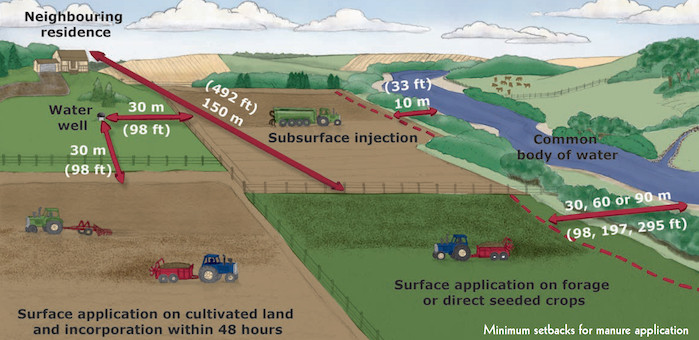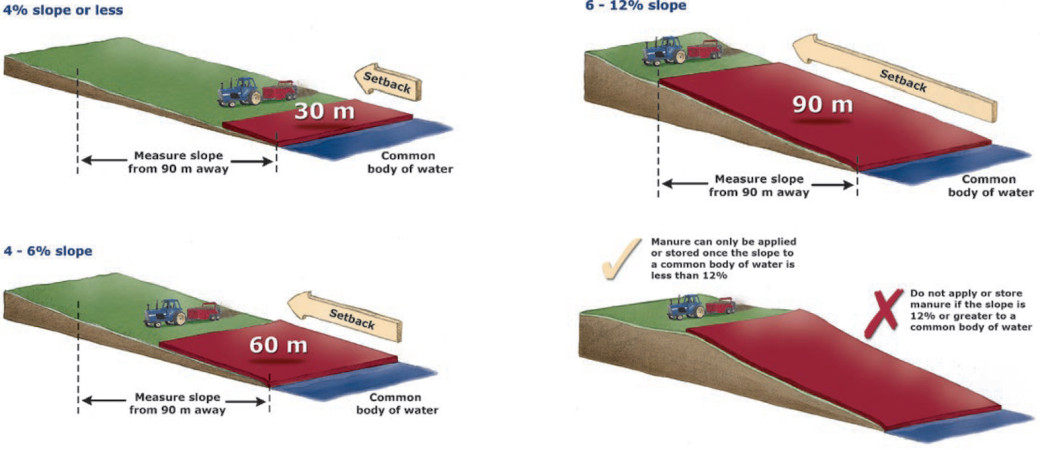Government mail service may be affected by the Canada Post labour disruption. Learn about how critical government mail will be handled.
Rules in Alberta
The Agricultural Operation Practices Act (AOPA) establishes manure management standards for all farming and ranching operations in Alberta. The 2008 Reference Guide simplifies AOPA and its regulations so anyone who handles manure, including compost and composting materials, can easily understand their obligations for responsible manure management. It is important to note that the legislation applies not only to livestock owners, but also to custom manure applicators and all farms that receive and spread manure.
In addition, Alberta’s Manure Spreading Regulations help reduce nuisance impacts on neighbours and minimize risk of manure runoff entering water supplies and common bodies of water.
When applying manure or catch basin contents and the crop is intended for human consumption, especially those eaten raw, there are guidelines and regulations to prevent food contamination. For more details, contact the Canadian Food Inspection Agency (CFIA) or a food safety certification organization
Irrigation of manure
A person who applies liquid manure or catch basin contents through an irrigation system must ensure that the manure or catch basin contents do not create a risk to the environment by:
- leaving the land to which they are applied,
- entering a common body of water, or
- becoming return flow.
Minimum setback distances
Manure must be applied at least:
- 150 m (492.2 ft) from a residence or other occupied building if manure is surface applied and not incorporated within 48 hours of the time when manure is first applied, unless it is impracticable to do so
- 30 m (98.4 ft) from a water well
- 10 m (32.8 ft) from a common body of water if subsurface injection is used
- 30 m (98.4 ft) from a common body of water if manure is surface applied and incorporated within 48 hours, except when applied on forage, direct-seeded crops, or frozen or snow-covered land; in such cases setback distances are based on slope of the land, see below.
Figure 1: Minimum setbacks for manure application

If the land slopes towards a common body of water, a person who applies manure on forage or direct-seeded crops must meet the following setback requirements based on the average slope of the land (see Figures 2 and 3 below).
Figure 2: Setbacks for manure application on land with various slopes

Figure 3: Determining slope

Spreading on frozen or snow-covered land
While spreading manure on frozen and snow-covered land is not encouraged, the legislation recognizes that there may be exceptional circumstances that create this need. Setback requirements must be followed if a farmer needs to spread manure on frozen or snow-covered land.
For confined feeding operations (CFOs), the owner or operator must obtain permission from the Natural Resources Conservation Board (NRCB) before spreading on frozen or snow-covered land. For more information, contact your local NRCB office.
Others, such as cow/calf operations that do not need to get permission, are encouraged to contact the NRCB. This way the inspector can help minimize any environmental risks and respond appropriately to any complaints.
To identify whether the land is frozen or snow-covered, refer to the Definitions for Frozen and Snow-covered Land.
For more information, refer to the NRCB fact sheet Applying Manure on Frozen or Snow-Covered Land.
Soil protection and analyses
Anyone who applies more than 500 tonnes of manure annually must perform the following soil analyses for each field that receives manure or manure compost:
- Soil salinity (electrical conductivity) in 0 to 15 cm depth
- Nitrate-nitrogen in 0 to 60 cm depth
- Soil texture of 0 to 15 and 15 to 30 cm depths
Soil analysis must be performed before manure application. Required soil tests do not have to be taken every year. However, records must not be older than 3 years except for soil texture, which is a one-time analysis.
Generally, manure must not be applied to land if the:
- electrical conductivity (EC) of the soil is greater than 4 deciSeimens per metre (dS/m) based on a 0 to 5 cm soil sampling depth
- amount of manure applied will increase the soil EC (0 to 15 cm depth) by more than 1 dS/m
- amount of manure applied will increase soil nitrate-nitrogen in the 0 to 60 cm depth to a level that equals or exceeds specified limits based on soil zone, soil texture, and depth to water table (see Table 1)
| Table 1. Soil Nitrate Nitrogen Limits in 0-60 cm | |||
|---|---|---|---|
| Soil Zone | >45% Sand and < 4 m to water table | > 45% Sand and > 4 m to water table | Medium and Fine Textured Soils |
| Brown | 80 kg/ha (75 lb/ac) | 110 kg/ha (100 lb/ac) | 140 kg/ha (125 lb/ac) |
| Dark Brown | 110 kg/ha (100 lb/ac) | 140 kg/ha (125 lb/ac) | 170 kg/ha (150 lb/ac) |
| Black | 140 kg/ha (125 lb/ac) | 170 kg/ha (150 lb/ac) | 225 kg/ha (200 lb/ac) |
| Gray (Luvisolic) | 110 kg/ha (100 lb/ac) | 140 kg/ha (125 lb/ac) | 170 kg/ha (150 lb/ac) |
| Irrigated | 180 kg/ha (160 lb/ac) | 225 kg/ha (200 lb/ac) | 270 kg/ha (240 lb/ac) |
Record keeping
AOPA requires that agricultural operations handling over 500 tonnes of manure annually keep manure management records for a minimum of 5 years. An NRCB Inspector may ask to see copies of these records when they are on site during an inspection resulting from a complaint.
Records that must be kept include:
- the identity of the persons controlling, handling and applying manure
- volume and weight of manure handled or spread
- application rates
- dates of handling
- where the manure is spread
For a complete list of required records, see Manure Management Record Keeping Regulations.
To help with farm management and record keeping, download the Alberta-based ManureTracker app for Android or iPad or iPhone.
Nutrient management plans
Nutrient Management Plans (NMPs) are not needed if AOPA manure application limits and soil protection requirements are met. An NRCB-approved NMP is required if there is not enough land base for a CFO, or if soil EC and/or nitrate-nitrogen loading limits will be exceeded by manure applications.
To determine land base requirements, see the land base tables in the Manure Characteristics and Land Base Code.
Manure nutrient content
To determine an appropriate manure application rate to meet crop requirements and minimize nutrient overloading, it is critical to know the nutrient content of the manure:
- You can use book values to estimate content, but this may not reflect the huge variability across different farms.
- The only accurate way to know the nutrient levels in manure is to have a lab analysis of a representative sample.
See the following factsheets on how to sample manure for lab analysis:
- Sampling Liquid Manure for Analysis
- Sampling Poultry Manure for Analysis
- Sampling Solid Manure for Analysis
If lab analyses are not available, the Manure Characteristics and Land Base Code or the following table can be used to estimate the plant nutrients in manure from various sources.
| Table 2. Estimated Nutrient Content of Livestock Manures* | ||||||
|---|---|---|---|---|---|---|
| Type of Livestock | Moisture % | Total N lbs/ton | Available N lbs/ton | Total P2O5 lbs/ton | Total K2O lbs/ton | |
| Beef | Feeders Finishers Feeder calves Cows w/calf Cows/Bulls | 30-70 (50) | 20 | 5.1 | 11.0 | 16.1 |
| Paved lot | 50-75 (65) | 14 | 5.4 | 3.9 | 9.1 | |
| Dairy | Free stall | 85-95 (92) | 8 | 3.6 | 3.9 | 10.0 |
| Tie stall Loose housing Replacements Calves | 70-85 (80) | 10 | 4.2 | 3.9 | 10.0 | |
| Swine | Liquid | 90-99 (96) | 7 | 3.2 | 5.0 | 4.0 |
| Solid | 40-70 (50) | 16 | 6.4 | 6.9 | 5.6 | |
| Poultry | Layers (solid) Belt cage | 30-60 (40) | 60 | 40.0 | 70.5 | 24.2 |
| Layers (solid) Deep pit | 30-60 (50) | 48 | 32.0 | 56.3 | 20.1 | |
| Layers (liquid) | 85-95 (90) | 12 | 8.0 | 11.5 | 4.8 | |
| Broilers Pullets | 30-50 (35) | 68 | 38.9 | 43.5 | 24.2 | |
| Breeders | 30-50 (35) | 60 | 34.3 | 43.5 | 24.2 | |
| Turkey Breeders | 30-50 (35) | 35 | 20.0 | 27.0 | 15.1 | |
| Horses | Feedlot | 30-60 (50) | 30 | 15.0 | 10.5 | 25.2 |
| PMU | 50-80 (75) | 12 | 6.0 | 6.0 | 12.1 | |
| Cervid | Elk & Deer | 25-50 (35) | 13 | 3.9 | 9.8 | 12.1 |
| Bison | 25-50 (35) | 13 | 3.9 | 9.8 | 12.1 | |
| Sheep | Ewes w/lambs Ewes/rams Feeders | 30-65 (50) | 20 | 8.0 | 9.8 | 25.2 |
| Lambs | 30-65 (50) | 14 | 5.6 | 9.8 | 25.2 | |
*Adapted from Appendix A-1 in 2000 Code of practice for responsible livestock development and manure management (AGDEX 400/27-2). Total N, Total P2O5, Total K2O include nutrients that are in the mineral (immediately plant-available water soluble) form and nutrients in the organic form that must undergo microbial decomposition in order to be plant-available. Available Nitrogen is the mineral form (usually ammonium) of Total N. Available Nitrogen is immediately plant-available but is also the form of nitrogen that is prone to losses through volatilization or gassing off. Nutrient composition is on a wet product or as-applied basis.
Manure application rates
Several factors must be considered and often many assumptions have to be made to determine how much manure should be applied. Manure application rates can be calculated based on the:
- nitrogen requirements of intended crops,
- phosphorus requirement of one or more years of crop production, or
- soil nitrate-nitrogen limits in the AOPA standards.
Each of these calculations will give a different answer about how much manure can be applied. Assumptions must be made about:
- the proportion of the nitrogen or phosphorus that is in the organic form
- the rate of nutrient mineralization each year
- the amount of nutrients lost after application that never becomes part of the soil-plant system
Important note: Salinity limits as described in the above Soil protection and analyses section can impact application frequency. AOPA soil limits can only be exceeded with prior approval from the NRCB.
Chapter 6.1 of the Nutrient Management Planning Guide provides practical examples of calculating manure application rates. The Alberta Farm Fertilizer Information and Recommendation Manager (AFFIRM) application is another useful tool for planning manure applications.
Stewardship funding
The new Sustainable Canadian Agricultural Partnership (Sustainable CAP) is a 5-year (2023-2028), $3.5 billion investment by federal‐provincial and territorial governments that sets out to strengthen competitiveness, innovation, and resiliency in the agriculture, agri‐food and agri‐based products sector.
The Sustainable CAP On-Farm Efficiency Program supports producers in achieving environmental benefits by improving the efficient use of agricultural inputs. These practices contribute to environmental sustainability by promoting the efficient use of natural resources.
The Resilient Agricultural Landscape Program helps producers improve the environmental resiliency of their land by encouraging adoption of beneficial management practices.
To stay current on program changes and news on future environment programming, see Sustainable CAP in Alberta.
Contact 310-FARM
Hours: 8:15 am to 4:30 pm (open Monday to Friday, closed statutory holidays)
Toll free: 310-FARM (3276) (in Alberta)
Phone: 403-742-7901 (outside Alberta)
Email: [email protected]